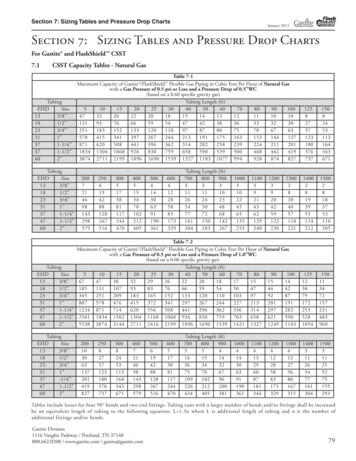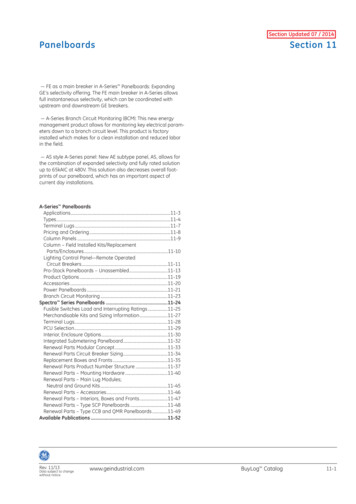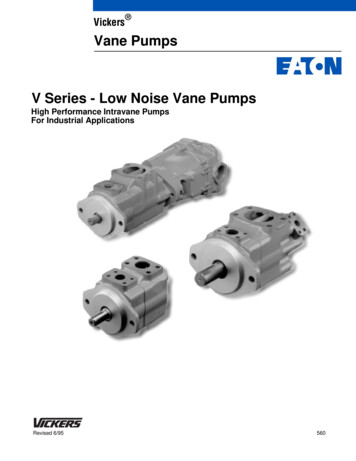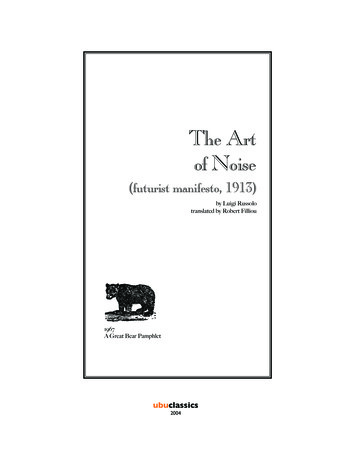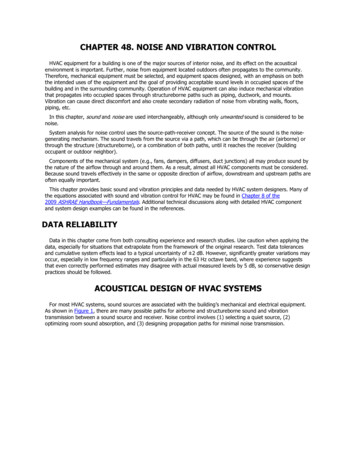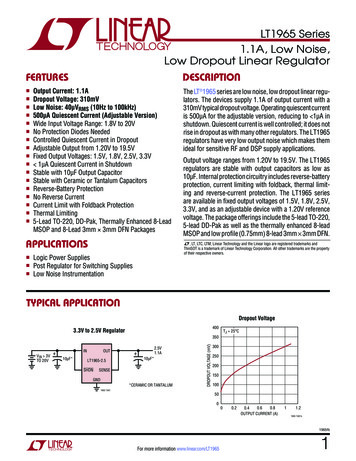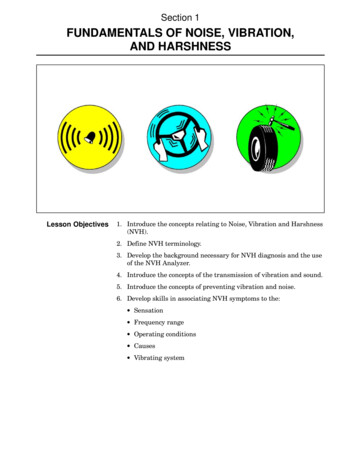
Transcription
Section 1FUNDAMENTALS OF NOISE, VIBRATION,AND HARSHNESSLesson Objectives1. Introduce the concepts relating to Noise, Vibration and Harshness(NVH).2. Define NVH terminology.3. Develop the background necessary for NVH diagnosis and the useof the NVH Analyzer.4. Introduce the concepts of the transmission of vibration and sound.5. Introduce the concepts of preventing vibration and noise.6. Develop skills in associating NVH symptoms to the: Sensation Frequency range Operating conditions Causes Vibrating system
Section 1IntroductionNoise and vibration normally exist in the operation of a vehicle.When they become unpleasant to the senses they may be regarded asproblems by the customer. NVH (Noise, Vibration and Harshness)is the term used when discussing these conditions.Noise, Vibrationand HarshnessFig. 1-1We experience vibration by our senses of touch and vision. Weexperience sounds by our sense of hearing. People can perceive thesame noise and vibration differently. To some it may be annoying, toothers merely unpleasant while others may not notice it until it ispointed out.Sensing VibrationsFig. 1-22LEXUS Technical Training
Fundamentals of Noise, Vibration, and HarshnessIntroductionContinuedThe NVH condition that is a concern does not have to be the strongestvibration or the loudest noise. It could be one that was not there beforeor one that is not acceptable to the customer. Therefore it is criticalthat we verify the customer’s complaint.For example:Tire pattern noise from a vehicle with block or lug pattern tirescould be acceptable to the owner of a 4 X 4. A complaint on the samevehicle could be much more subtle, caused by a driveline problem.Because we sense vibration and sound using different senses, we tendto discuss them separately. But vibration and sound are essentiallyidentical.A sound is a vibration (pressure fluctuation) of the air.Vibrations and sounds are both expressed as waves per second calledHertz (Hz), discussed in detail later. Vibrations that are felt are under 200Hz Vibrations between 20Hz 20,000Hz are audible by humans Vibrations over 20,000Hz are ultrasonic and not audible by humans
Section 1Frequency Rangesof Vibration andSoundFig. 1-34LEXUS Technical Training
Fundamentals of Noise, Vibration, and HarshnessAudible RangeFig. 1-4Characteristicsof vibrationIntroduction NVH phenomena can be a difficult concept to grasp. It is similar to theconcept of electricity, we only experience the results in both cases. Wecannot see it as easily as a broken or worn component.For example:The light from a light bulb is not electricity, but the result ofelectricity. The movement felt by a customer is not the source of thevibration. It occurs as a result of a condition such as an imbalance.Vibrations, like electricity, have basic characteristics which arealways present. Understanding these characteristics will allow atechnician to predict the source of a vibration.
Section 1Vibration The up and down movement of the weight and spring model shownbelow represents a vibration. This movement or vibration exists as aresult of a weight suspended by a spring and an external force.The factors that determine movement or vibration are: The size of the spring The size of the weight The amount of force pulling on the weight starting it in motionThe model consisting of the suspended weight and spring is called thevibrating system.Anything that vibrates is a vibrating system including: A string on a musical instrument A bell A tuning forkThe weight and spring model or vibrating system can be started intomotion by pulling on the weight. This action is known as the vibratingforce. A vibrating force is the external force or energy putting avibrating system into motion.Plucking a string on a guitar or striking a bell or tuning fork are thevibrating forces that cause these vibrating systems to vibrate andmake noise.6LEXUS Technical Training
Fundamentals of Noise, Vibration, and HarshnessVibrationFig. 1-5Vibration For example:ContinuedA vibrating system in a vehicle is the suspension. The spring on the vehicle is similar to the spring on the model. The weight of the vehicle is similar to the weight on the model. Bumps in the road are the external or vibrating forces that startthe vehicle into motion.If you remove the shock absorbers a vehicle will move or vibrate ina similar manner to the weight and spring model.A technician can bounce a corner of a vehicle and watch the motion tocheck for bad shocks. If the shocks are good they will dampen themotion quickly.
Section 1Vehicle Movementwithout ShocksFig. 1-6Oscillation is another term used to describe the movement of avibration. When something oscillates it moves back and forth around acommon point.8LEXUS Technical Training
Fundamentals of Noise, Vibration, and HarshnessCycle If a constant vibration or movement in any vibrating system is plottedover time a pattern appears. This pattern consists of the repetitivemovement of the weight.Tracing this pattern from the resting position through each extremeand back to the resting position will produce one cycle.CycleFig. 1-7Cycle comes from the word circle. The travel of the weight on eitherside of the resting position, is half of a circle.The distance the weight travels from either side of the resting positionwill be the same as long as the vibrating force remains constant.A B
Section 1Cycle The movement/vibration will continue until the energy in the system isContinueddissipated and the system is at rest.Dissipation ofEnergy from aSingle ImpactFig. 1-8For example:Another example of frequency or cycle is rotating a crankshaft 360 starting at TDC. This movement is one revolution. We measurethe speed of an engine by counting these revolutions in oneminute (RPM).Rotating the crankshaft from TDC through 360 and back to TDC isalso one cycle of the crankshaft. As defined above the crankshaftstarts at a specific point, travels in a circle and returns to the samepoint.Plotting the movement of a crankshaft over time will result in asimilar pattern to the movement of the spring and weight model.(Fig. 1 7)10LEXUS Technical Training
Fundamentals of Noise, Vibration, and HarshnessFrequency The number of cycles in one second is the frequency of the vibration.The unit for frequency is Hertz (Hz).FrequencyFig. 1-9The number of cycles in a second or the frequency (Hz) can be changedby changing the vibrating system. If the strength of the spring ischanged or the size of the weight is changed the frequency will change.(All other aspects of the vibrating system unchanged) A stronger spring will increase the frequency (Hz) More tension will move the weight at a faster speed A weaker spring will decrease the frequency (Hz) Less tension will move the weight at a slower speed A heavier weight will decrease the frequency (Hz) More weight will increase the resistance on the spring and it willmove at a slower speed A lighter weight will increase the frequency (Hz) Less weight will decrease the resistance on the spring and it willmove at a faster speed
Section 1VibrationCharacteristicsFig. 1-10Sensors SignalFig. 1-11Ne SIGNAL (Crankshaft RPM)G SIGNAL (Crankshaft Position)WHEEL SPEED SENSORS FOR ABS12LEXUS Technical Training
Fundamentals of Noise, Vibration, and HarshnessCalculating Frequency can also be expressed in Revolutions Per Minute (RPM).Component RPM is a common unit for rotating components in the automotiveFrequency field. RPM can be converted to Cycles Per Second (CPS) or Hertz(Hz) by dividing RPM by 60. There are 60 seconds in one minute.RPM 60 sec CPS or HzIf a crankshaft is rotating at 3000 RPM then it has a frequency (Hz) of50 CPS or 50 Hz.3000 RPM 60 sec 50 HzThis formula can also assist the technician in identifying the source ofa vibration in a vehicle. If the frequency is known then the RPM can becalculated.Hz x 60 sec RPMA technician can now determine what component is turning at a calculatedRPM, during the vehicle conditions at which the complaint occurs.For example: Engine RPM can be read from a tachometer 3000 RPM Driveline RPM is the same as engine RPM in fourth gear with a 1:1gear ratio. (Manual Transmission)Engine @ 3000 RPM 1 3000 RPM drivetrain speed 3000 RPM 50 Hz (engine speed and driveshaft speed).If the gear ratio is other than 1:1, the engine RPM divided by the ratioequals the driveline RPM. (5th gear, W58 trans.)Engine @ 3000 RPM 0.783 3831.42 RPM driveshaft speed 3831.42 RPM 63.85 Hz (driveline speed) Wheel RPM is calculated by dividing the RPM of the driveline bythe gear ratio of the differential. (’93 Supra 2JZ GE)Driveline @ 3831.42 RPM 4.272 896.87 RPM wheel speed 896.87 RPM 14.95 Hz (wheel speed)The frequency (Hz) of the vibration or sound can be determined withthe use of test equipment. A vibration analyzer is able to display thevibrations in a vehicle. An abnormal vibration can be associated with aspecific frequency from the display.For example:The engine could be determined as the source of a measured 50 Hzvibration with the crankshaft turning at 3000 RPM.
Section 150 Hz x 60 sec 3000 RPM14LEXUS Technical Training
Fundamentals of Noise, Vibration, and HarshnessAmplitude The amount of vertical movement of the spring and weight (vibratingsystem) is the amplitude of the vibration. The amplitude is determinedby the external force or energy applied to the vibrating system.Amplitude is the size of the wave and is measured two ways. Total amplitude from peak to peak (A) Half amplitude from resting position to the peak (B)The higher the amplitude, the more noticeable the condition.AmplitudeFig. 1-12Vibration A vibration is measured in two ways:Measurement Frequency (Hz) Amplitude (dBg)Frequency is a function of the system design and amplitude is theresult of the energy on the system.Both of these features can be measured with a vibration analyzerwhich senses, processes and displays the vibrations in a vehicle. Theinformation from a vibration analyzer can help the techniciandetermine the: Frequency of vibration (Hz) which can indicate the source
Section 1 Amount of energy/amplitude(dBg) which indicates the level of thevibration the customer feels16LEXUS Technical Training
Fundamentals of Noise, Vibration, and HarshnessThe vibration analyzer recommended by Toyota is a feature of theToyota Diagnostic Tool Set. The NVH portion of the tool includes: An accelerometer to sense the vibration A data link to input RPM and MPH A program card specific to the NVH functionNVH AnalyzerFig. 1-13
Section 1The tool will display the vibrations occurring in a vehicle and aid thetechnician in diagnosing an NVH complaint.The unit of measurement used by the NVH Analyzer for: Sound level is the dB (decibel) Vibration level (amplitude) is dBg (g force related to gravity)The dB is the unit of measurement related to the level or intensity ofwhat we hear. It is a mathematical calculation (logarithm) of avibrating force that produces a sound. It is useful to associate the levelor amplitude of the vibration to the level sensed by the customer.The dBg is the unit that is related to the level or intensity of what wefeel. When measuring the level or amplitude of a vibration withoutsound the unit g is added to associate the force of the vibration togravity. This is similar to measuring the weight of an object which isalso a function of gravity.Level or amplitude becomes important in determining the success of therepairs performed. If the amplitude of a vibration or sound is measuredbefore and after a repair then a comparison can be made. The resultsare much more objective than using the senses of touch and hearing.dB (DECIBEL)Fig. 1-14 The graph on the left shows the actual sound level from varioussources.18LEXUS Technical Training
Fundamentals of Noise, Vibration, and Harshness The graph on the right shows the customer perceived sound levelfrom the same sources and easier to read.Natural Frequency All vibrating systems have a specific vibrating frequency unique tothat system design. This frequency is called the natural frequency.If any of the characteristics of the vibrating system change then thenatural frequency changes. (as stated in the section on frequency)If the external force on a vibrating system is changed then theamplitude changes but the natural frequency remains the same.Natural FrequencyFig. 1-15A vibration or sound that develops in a vehicle may be caused by achange in the status of a component like a bad seal in a strut. Thenatural frequency of the suspension system is changed due to the lossof dampening in the strut. The suspension system will now vibratenoticeably over the same road conditions which had not previouslycaused a customer complaint.In this example the technician can resolve the customer complaint byrestoring the suspension system to the original condition and naturalfrequency.
Section 1Resonance Resonance occurs when the vibrating force (external force) on avibrating system is moving at the same frequency (Hz) as thenatural frequency of that vibrating system. Fig. 1 15 shows the waveform of the natural frequency of the system and the wave of thevibrating force at the same frequency. The resulting wave that occurs isat the same frequency but with much greater amplitude.This is a significant phenomenon in a vehicle because the increasedlevel is sensed by the customer and perceived to be a problem.ResonanceFig. 1-16The frequency (Hz) at which this occurs is the resonance point".The amplitude (dBg) of the vibrating system increases dramaticallywhen the resonance point is reached.20LEXUS Technical Training
Fundamentals of Noise, Vibration, and HarshnessResonance PointFig. 1-17Resonance In the above example with the suspension system vibration (caused byContinuedthe leaking strut), the vibration the customer feels is amplified when: The new natural frequency of the suspension system
Vibration level (amplitude) is dBg (g force related to gravity) The dB is the unit of measurement related to the level or intensity of what we hear. It is a mathematical calculation (logarithm) of a vibrating force that produces a sound. It is useful to associate the level or amplitude
